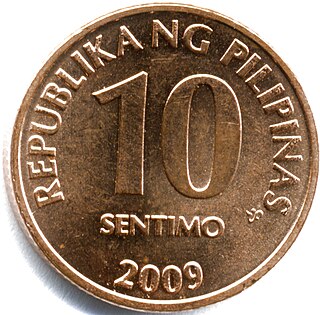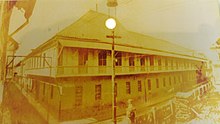The Mexican peso is the official currency of Mexico. The peso was first introduced in 1863, replacing the old Spanish colonial real. The Mexican peso is subdivided into 100 centavos, represented by "¢". Mexican banknotes are issued by the Bank of Mexico in various denominations and feature vibrant colors and imagery representing Mexican culture and history. Modern peso and dollar currencies have a common origin in the 16th–19th century Spanish dollar, most continuing to use its sign, "$".

The Philippine peso, also referred to by its Filipino name piso, is the official currency of the Philippines. It is subdivided into 100 sentimo, also called centavos.

The Spanish dollar, also known as the piece of eight, is a silver coin of approximately 38 mm (1.5 in) diameter worth eight Spanish reales. It was minted in the Spanish Empire following a monetary reform in 1497 with content 25.563 g (0.8219 ozt) fine silver. It was widely used as the first international currency because of its uniformity in standard and milling characteristics. Some countries countermarked the Spanish dollar so it could be used as their local currency.

The United States Mint is a bureau of the Department of the Treasury responsible for producing coinage for the United States to conduct its trade and commerce, as well as controlling the movement of bullion. The U.S. Mint is one of two U.S. agencies that manufactures physical money. The other is the Bureau of Engraving and Printing, which prints paper currency. The first United States Mint was created in Philadelphia in 1792, and soon joined by other centers, whose coins were identified by their own mint marks. There are currently four active coin-producing mints: Philadelphia, Denver, San Francisco, and West Point.

The Colombian peso is the currency of Colombia. Its ISO 4217 code is COP. The official peso symbol is $, with Col$. also being used to distinguish it from other peso- and dollar-denominated currencies.

The Cuban peso also known as moneda nacional, is the official currency of Cuba.

Philippine peso coins are issued by the Bangko Sentral ng Pilipinas for circulation in the Philippines and are currently available in seven denominations. The Philippine peso has been in use since Spanish rule.

The Dominican peso, officially the peso dominicano since 2010, is the currency of the Dominican Republic. Its symbol is "$", with "RD$" used when distinction from other pesos is required; its ISO 4217 code is "DOP". Each peso is divided into 100 centavos ("cents"), for which the ¢ symbol is used. With exception of the United States dollar, it is the only currency that is legal tender in the Dominican Republic for all monetary transactions, whether public or private.

The venezolano was the currency of Venezuela between 1872 and 1879. It was divided into 100 centavos, although the names céntimo and centésimo were also used. Venezolano was also the name of two currencies planned in 1854 and 1865.

Emergency circulating notes were currency printed by the Philippine Commonwealth Government in exile during World War II. These "guerrilla pesos" were printed by local government units and banks using crude inks and materials. Due to the inferior quality of these bills, they were easily mutilated.

This article provides an outline of the currency of Spanish America from Spanish colonization in the 15th century until Spanish American independencies in the 19th. This great realm was divided into the Viceroyalty of New Spain, which came to include all Spanish territory north of Panama, the West Indies, Venezuela, and the Philippines, and the Viceroyalty of Peru, which included Panama and all Spanish territory in South America except Venezuela. The monetary system of Spanish America, originally identical to that of Spain, soon diverged and took on a distinctive character of its own, which it passed on to the independent nations that followed after.

The one-sentimo coin (1¢) is the smallest-denomination coin of the Philippine peso. It has been issued since 1903 during American rule. It became the smallest unit of currency following the removal of the half-centavo in 1908.

The five-sentimo coin (5¢) coin is the second-lowest denomination coin of the Philippine peso after the one sentimo.

The ten-sentimo coin (10¢) coin is a denomination of the Philippine peso. It was the oldest denomination under 1 peso in the country's circulation, having been introduced in 1880 during the Spanish rule of the islands until it stopped being minted in 2017. The denomination remains legal tender until the demonetization of the BSP Coin Series.

The twenty-five-sentimo coin (25¢) is the third-lowest denomination coin of the Philippine peso.
The history of Philippine money covers currency in use before the Hispanic era with gold Piloncitos and other commodities in circulation, as well as the adoption of the peso during the Hispanic era and afterwards.

The Philippine fifty-centavo coin (50¢) was a denomination of Philippine currency. It was minted for the Philippines from 1864 to 1994 and was demonetized in 1998.

The Philippine twenty-centavo (20¢) coin was a denomination of the Philippine peso. The one-fifth (1/5) peso was introduced by both the Spaniards and the Americans during the colonial era of the Philippines. It was replaced by a banknote of the same denomination introduced alongside the establishment of the Central Bank of the Philippines in 1949 and it was replaced by the twenty-five centavo coin.

The Philippine half-centavo coin (½¢), a denomination of Philippine currency, was issued when the Philippines was under US administration. It bears the names of both countries: Filipinas and the United States of America.

The Flora and Fauna Series was a series of Philippine peso coins minted from 1983 to 1994, in denominations from 1 sentimo to ₱2. The series used the Optima typeface as their main text. The sizes of the coins were reduced in 1991, and the ₱5 coins were reintroduced in 1991. Production of 50-sentimo and ₱2 coins ceased in 1995.




















